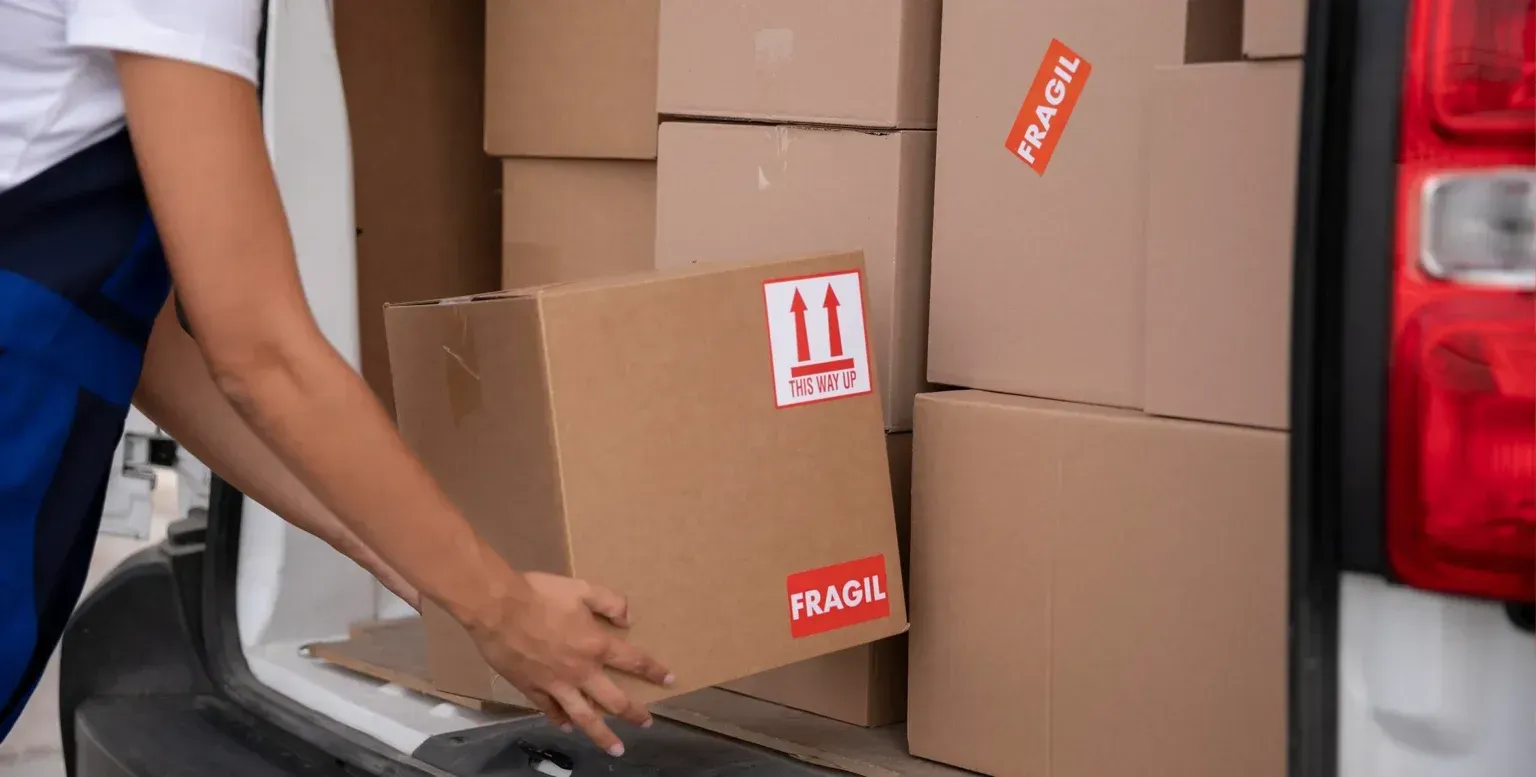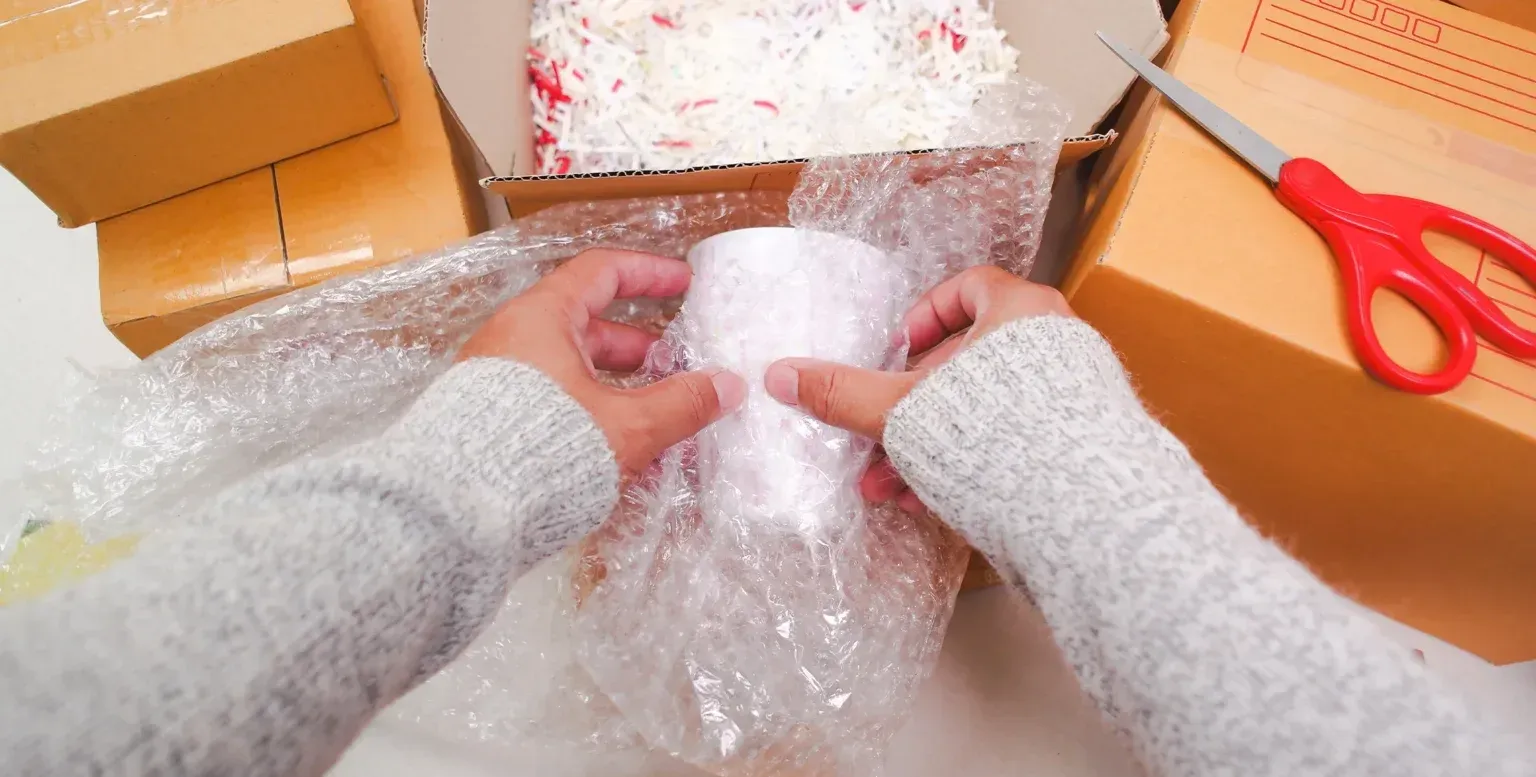How to Pack Fragile Items Before Moving
List of Services
If you’ve ever unpacked at your new home only to find shattered dishes or a cracked TV screen, you know how heartbreaking and expensive it can be. That’s why learning how to pack fragile items before moving is one of the smartest things you can do before moving day.
In fact, moving isn’t a small event in the U.S. According to the Census Bureau, about 12.1% of Americans relocated in 2024. With full-service moves averaging around $9,000, even a single broken box of dishes or electronics can feel like a punch to the wallet.
Packing may seem like just wrapping and boxing, but it’s really a system that decides whether your fragile belongings survive the journey intact or not.
That’s why having the right plan and applying powerful fragile packing tips makes all the difference. From knowing the best way to pack fragile items like glassware and mirrors, to figuring out how to pack delicate items, the goal is to pack fragile belongings safely without the stress.
This guide is your complete roadmap you can follow step by step, so that when you’re wrapping fragile items before moving, you do it with confidence.
Pre-Packing Preparation
Before you get into the bubble wrap and boxes, it’s important to take a few steps back to make the process much easier.
Declutter & Inventory
The first step is to go through all your fragile items and decide what really deserves a spot in the moving truck. It’s easy to collect chipped plates, unused mugs, or glassware you haven’t touched in years. Letting those go now means fewer things to pack and less chance of clutter in your new home.
Once you’ve narrowed it down, make a simple inventory list. An inventory helps you keep track of boxes and is also useful if you need to prove what you had packed later on.
Measure & Plan Space
After decluttering, measure any larger, fragile pieces such as mirrors, framed art, or appliances. Knowing the size in advance helps you choose the right boxes or special
packing materials. It also gives you a clear idea of how everything will fit in the moving truck.
A simple rule is to place heavy boxes at the bottom and lighter, delicate items toward the top. This prevents crushing and keeps your valuables protected during the ride.
Set Up a Packing Area
Finally, create a space where you can pack without distractions. A waist-high table with good lighting works best because it saves your back and helps you see exactly what you’re doing. Keep your tape, bubble wrap, packing paper, and markers close by so you’re not running around the house looking for supplies.
Materials You Actually Need (and Why)
Core list (buy this first)
- Double-wall dish barrelboxes
- Small & medium moving boxes (heavy-duty where possible)
- Cell/divider kits for glassware
- Bubble cushion + foam sleeves + packing paper (newsprint)
- Corner protectors (frames/mirrors), flat picture boxes
- Anti-static bags (electronics), stretch wrap, zip-top bags
- High-tack packing tape + tape gun; markers; “FRAGILE / THIS SIDE UP”labels
How many boxes and supplies?
If you’re packing a typical U.S. 1-bedroom, expect ~20–45 boxes, with most being medium (3 cu ft) and small (book boxes), plus specialty dish/picture boxes. Kits (e.g., “1–2 bedroom” box kits) bundle exactly what you’ll need.
Box Sizes, Uses & Sensible Limits
Rule of thumb:
Heavy, fragile items should always go in smaller boxes, while bulky but light items belong in larger ones. Most retailers rate boxes up to 65 pounds, but in practice, it’s smarter to keep them lighter.
| Box Type | Typical Dimensions (approx.) | Best For | Practical Max (aim) |
|---|---|---|---|
| Small / Book | ~16″×12″×12″ | Books, tools, canned goods, dense, fragile | ≤ 50–65 lb. |
| Medium (3 cu ft) | ~18″×18″×16″ | Kitchen items, decor, glassware (with cells | ≤ 50–65 lb. |
| Large | ~18″×18″×24″ | Linens, pillows, plastics (light stuff) | ≤ 40–50 lb. |
| Extra-Large | ~24″×20″×21″ | Comforters, bedding, lampshades | ≤ 30–40 lb. |
| Dish Barrel (double wall) | ~18″×18″×28″ | Plates, bowls, serving ware | Keep near 65 lb., even if rated higher |
Packing Principles That Prevent Breakage
When you’re learning how to pack fragile items before moving, there are a few golden rules that make the difference between arriving with everything intact and opening boxes full of broken pieces.
These principles are simple but powerful, and once you follow them, you’ll feel a lot more confident about your packing.
Cushion → Immobilize → Isolate → Seal → Label
Start by padding the bottom of the box with paper or bubble wrap. Wrap each item individually and use dividers or crumpled paper to keep things from shifting around. Once the box is full, seal it by using the “H-tape” method (taping both edges and the center seam) and add labels on at least two sides plus the top.
Do the shake test
Before sealing completely, close the box and give it a gentle shake. If you hear movement, add more filler until everything is snug. Silence is your green light.
Heavy goes low, light goes high
Always place heavier items at the bottom and lighter, delicate items like glassware or bowls on top. This prevents crushing and keeps your fragile belongings safe during the move.
Stand plates vertically
Instead of stacking plates flat, place them on their edges, like records in a crate. They’re stronger this way and less likely to crack under pressure.
Double-box the ultra-delicate
For fragile pieces like fine crystal, collectibles, or electronics, use a smaller box inside a larger one with padding in between. This “box-in-box” method adds an extra layer of protection.
Document high-value items
Take quick photos of valuable items before sealing the box. Keep an inventory; it not only helps with tracking but also makes things easier if you ever need to file a claim.
Side note: If you’re using professional movers, remember that items worth more than $100 per pound (like expensive electronics or artwork) should be listed separately under Full Value Protection to ensure they’re covered.
Step-by-Step Packing Process
If you want to know the best way to pack fragile items, this five-step process is the one to follow every single time. The steps are simple, repeatable, and designed to keep your things safe no matter how far they travel.
Prep the Box
Start by lining the bottom with a cushion of crumpled paper, foam, or bubble wrap, about two to three inches thick. This layer acts like the shock absorber in a car, protecting whatever goes inside. Before you put anything in, pre-label the box with the room name, what’s inside, and arrows for orientation.
Wrap Each Piece
Every fragile item needs individual attention. Use packing paper for most things, and bubble wrap for extra delicate items like glassware, stemware, or collectibles. Focus especially on edges, corners, handles, and stems; these are the first spots to break during a move. When you’re wrapping fragile items before moving, don’t skimp on materials.
Place Items and Immobilize
Once everything is wrapped, start filling the box. Always put heavier items at the bottom and lighter, delicate items on top. Use dividers or cell kits for glasses so they don’t knock against each other. If you do it correctly, even if the box is slightly tilted, your belongings won’t budge.
Fill Empty Spaces (Void Fill)
After placing the items, fill every gap with crumpled paper, foam peanuts, or air pillows. Pay attention to the corners and sides, and then add a soft layer on top before closing the box. This keeps things from moving and adds another buffer against bumps in the road.
Seal and Mark Clearly
Once the box feels snug, seal it by using the “H-tape” method: one strip along the center seam and one along each edge. This locks the flaps in place and keeps the box from popping open. Finally, mark the box clearly on at least two sides and the top with “FRAGILE” and “THIS SIDE UP.” Add arrows for orientation.
Room-by-Room Strategy
Packing fragile items becomes much easier when you tackle them room by room. Each space in your home has its own tricky items, so here’s how to handle them safely and smartly.
Kitchen
The kitchen is usually the most fragile-heavy room in the house. Here’s how to handle it:
- Plates & Bowls: Wrap individually; stack vertically like records in a dish barrel. Fill gaps with crumpled paper.
- Glasses & Stemware: Use cell dividers; wrap stems and rims with extra padding.
- Mugs & Cups: Wrap handles first, then cover the entire mug.
- Pots & Pans with Glass Lids: Wrap lids separately; store upright with padding.
- Knives: Use blade guards or cardboard sheaths; bundle carefully and label “Sharp.”
- Small Appliances (toasters, blenders, mixers): Remove loose parts, secure cords, wrap bases, and pack in sturdy boxes.
Living Room
Living rooms mix fragile decor with expensive electronics, so double-check everything here.
- TVs & Monitors: Original box if available; otherwise, bubble wrap + cardboard screen protector + TV box. Always keep upright.
- Speakers, Consoles, DVD players: Wrap in bubble; use anti-static bags for small parts; bag and label cords.
- Frames, Mirrors & Artwork: Use corner protectors; pack upright in picture boxes; tape an “X” across glass to minimize shatter risk.
- Vases, Figurines, Collectibles: Wrap in bubble or foam sleeves; double-box delicate pieces.
- Coffee Tables with Glass Tops: Remove the glass and wrap it separately in cardboard and bubble wrap.
Bedrooms
Bedrooms seem simple, but they often hide fragile surprises.
- Lamps: Remove bulb and shade; wrap base carefully; pack shades in their own box with nothing else inside.
- Mirrors: Wrap with corner protectors; always transport upright.
- Picture Frames: Small ones can be grouped with padding; large ones are upright in picture boxes.
- Jewelry & Watches: Small valuables should travel with you, not movers. Pack in padded cases if necessary.
- Decor Items: Candles, ceramics, or glass decor should be wrapped individually and cushioned in small boxes.
Office (Monitors, PCs, Gadgets, Documents)
Your home office is full of sensitive and expensive equipment. Handle it carefully:
- Desktop PCs: Remove loose parts, add anti-static wrap, and box securely.
- Monitors: Wrap with bubble + cardboard screen protector; use monitor/TV boxes.
- Laptops & Tablets: Carry these with you if possible; otherwise, wrap and double-box.
- Printers: Remove cartridges, tape moving parts, and wrap the unit before boxing.
- Cameras & External Hard Drives: Use padded cases or anti-static bags.
- Important Documents:
Fireproof folders or small lockboxes; keep these in your personal vehicle, not with movers.
Loading the Moving Vehicle
How you load the truck is just as important as how you pack the boxes. Even well-wrapped items can break if they’re stacked or placed the wrong way.
Here’s how to keep things safe.
Build the Base
Start with your heaviest, sturdiest boxes on the bottom. These create a solid foundation. Never put fragile boxes under heavy loads; this is where most accidents happen.
Give Fragile Boxes Their Own Space
Fragile items should sit at shoulder height or above, where they won’t get crushed. Keep them snug, use straps if possible, and don’t wedge them in awkward spots. This is one of the easiest fragile packing tips to move belongings safely.
Handle Large Fragile Pieces Carefully
Keep TVs, mirrors, and artwork upright against the wall of the truck. Add blankets or cardboard between them and secure them with straps so they don’t tip over.
Load Essentials Last
Boxes you’ll need right away, like fragile kitchen items, lamps, or electronics, should go in last. That way, they’re the first to come out at your new place.
Common Mistakes to Avoid

Even when people know how to pack fragile items before moving, a few small mistakes can undo all their effort. Here are the most common ones to watch out for:
Overpacking Large Boxes
Trying to fit too many fragile items into one big box is a recipe for breakage. Heavy boxes are hard to carry and more likely to get dropped. Stick with smaller boxes for dishes, glassware, and other delicate items.
Skipping Cushioning
One of the biggest mistakes when wrapping fragile items before moving is rushing through it or using too little padding. Every item should be wrapped and cushioned, especially edges, corners, and handles.
Leaving Empty Spaces
If there are gaps inside the box, items will shift and bump into each other. Always fill the voids with paper, foam, or bubble wrap to keep things snug.
Poor Labeling
A box that isn’t clearly marked “Fragile” is more likely to end up under something heavy. Label on multiple sides so it can be seen no matter how the box is stacked. This is a simple, fragile packing tip that saves a lot of heartache.
Ignoring Orientation
Plates, mirrors, and TVs should travel upright, not flat. Ignoring this rule often leads to cracks and chips during transport.
Recommended Resources
DIY vs. Professional Movers – What’s Best for Your Budget?
FAQs
What is the safest material to wrap fragile items in?
Bubble wrap is the safest option for very delicate items like glassware and electronics, but packing paper works best for everyday kitchen items because it grips surfaces better. Many movers recommend using a mix of both for the best protection.
Can I use clothes or towels instead of packing materials?
Yes, soft items like clothes, towels, or blankets can be used to cushion fragile belongings. They work well for saving money and space, but they don’t provide the same shock protection as bubble wrap or foam. It’s best to combine them with proper packing supplies
How early should I start packing fragile items before a move?
Begin packing fragile items at least two weeks before your move. These items aren’t usually used daily, so starting early reduces stress and gives you time to pack them carefully.
Is it better to hire movers to pack fragile items?
If you have valuable or irreplaceable items, hiring professional movers can be well worth the cost. They have the right materials and experience to pack efficiently. However, with the right supplies and time, you can safely pack fragile belongings yourself.
What should I do if a fragile item breaks during the move?
Take photos of the damaged item and the box it was in before throwing anything away. If you hired movers, file a claim within the required timeframe. If you moved yourself, check whether your homeowners or renters’ insurance offers coverage.


